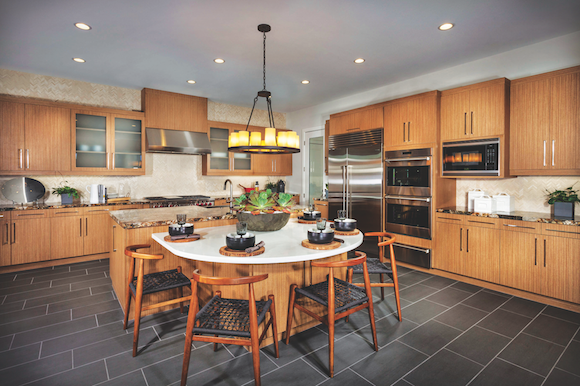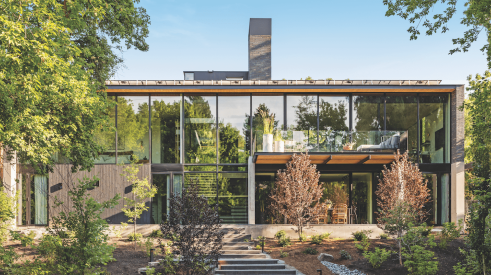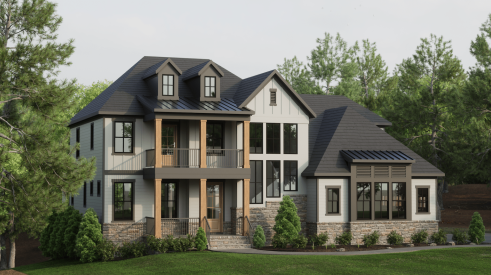If you’re an architect or an architecture buff, the word “contemporary” may conjure up visions of a simple white box with a flat roof and large panes of glass. But the version of contemporary seen in most new production homes doesn’t hew very closely to this vision, at least not in suburban, single-family detached homes. The necessity of going to market with a product that homebuyers want has spawned contemporary interpretations that are layered over traditional archetypes.
Contemporary housing has more of a foothold in urban areas “where there’s some context of other contemporary forms and shapes,” says Greg Bucilla, president of Bucilla Group Architecture, in Irvine, Calif. “Traditional has long been the eye candy for homebuyers in a suburban environment. That’s why I think public home builders are gravitating to more urban areas and grasping contemporary.”
Architect Don Meeks, CEO of Meeks + Partners, in Houston, says that cutting-edge contemporary is generally found on the West Coast and in cities such as Austin, Dallas, and Houston, Texas; Charlotte, N.C.; Nashville, Tenn.; and Denver. Zoning may restrict the extent to which designers can experiment; in more conservative markets, window groupings or a monochromatic color palette may be the only nods to contemporary.
Even in Nashville there are neighborhoods where Meeks + Partners has a lot of creative freedom, and others that endorse only “classic” contemporary, where, Meeks says, “the home may have traditional brick and nice cornice details, and we’ll come in with floor-to-ceiling glass to give it an Urban Outfitters’ look.”
Upwardly mobile individuals with purchasing power who are keen on new types of homes are the most likely to embrace contemporary design, Bucilla says. “It tends to be more of a subtle movement [toward] multifamily rather than detached,” he adds.
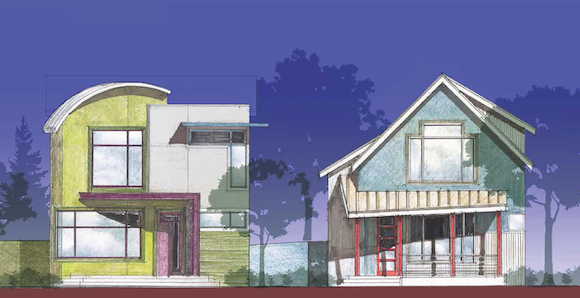
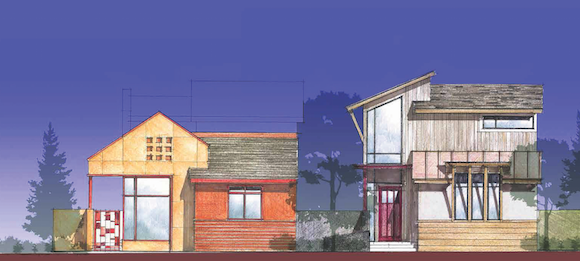 DTJ Design's work for Brookfield Residentail in Denver's Midtown Community. [Renderings: DTJ Design]
DTJ Design's work for Brookfield Residentail in Denver's Midtown Community. [Renderings: DTJ Design]
For a detached project to succeed, “it would probably have to be a small-lot, high-density, alley-loaded condition that takes the garage and the driveway off the street and makes it more aesthetically pleasing for the buyer.” [Read about Brookfield’s detached homes at Midtown in Denver, shown here.]
For this reason, multifamily buildings are more daring in their approach to contemporary design. “Contemporary today has a lot of openness and exciting geometry,” Meeks says. “Instead of a conventional bay window, you might see a trapezoidal window or a pop-out bay. And it utilizes different materials such as metal siding and panels.”
Bright, flashy colors may be used to accent a bay window, room projection, or inset balcony. Flat roofs open up possibilities for rooftop terraces and sky lounges. Other features include angled walls, floor-to-ceiling glass, and glass handrails.
Urbane Buyers Lead the Way
Like Bucilla, Tom Grable, president of the Southern California division of TRI Pointe Homes, in Irvine, Calif., believes contemporary architecture is more prevalent in “urbanized” areas. That doesn’t necessarily mean downtown Los Angeles or Long Beach. “It can mean places like Irvine, a bedroom community in Orange County that has a fair amount of commerce, and infill sites such as Playa Vista on the west side of Los Angeles,” Grable says.
Urbanized environments attract buyers who are typically younger, more urbane, and more cosmopolitan. “People with high-tech or engineering jobs like things that look and feel techy and have practical applications, while those in the entertainment industry are highly creative and seek housing that’s new and exciting,” he says. “A lot of them want to be different for different’s sake.”
Influenced by the work of Irving Gill, an early 20th-century modernist architect, TRI Pointe’s detached homes at Woodson in Playa Vista have generated strong market response. The homes have parapet roofs that look flat but don’t have drainage issues. Yet the company is selective about where it builds contemporary houses.
“We would not do a Woodson type of product in, for example, South Orange County or Santa Clarita, at least not in a traditional subdivision, because buyers in those markets have told us they prefer a more traditional application as far as the outward appearance of the home,” Grable says. “But when you cross over into the [interior] merchandising, that opens up another level of contemporary design they may gravitate to because it reflects the style and tastes of the time.”
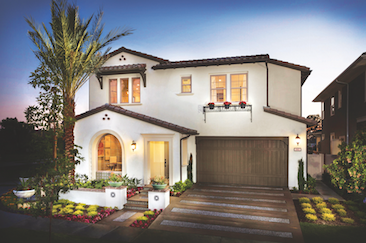 Residence 3 at Truewind, in Huntington Beach, Calif., has the traditional façade that buyers prefer but the interior merchandising is transitional, which blends contemporary and traditional elements. [Illustration: Meeks + Partners]
Residence 3 at Truewind, in Huntington Beach, Calif., has the traditional façade that buyers prefer but the interior merchandising is transitional, which blends contemporary and traditional elements. [Illustration: Meeks + Partners]
Stylistic Roots
Contemporary design has historical precedents in the International Style, which was developed in Europe and the U.S. in the 1920s and 1930s and is characterized by rectilinear forms completely stripped of applied ornamentation and decoration. The interior spaces are open and the materials are typically glass and steel, in combination with less visible reinforced concrete.
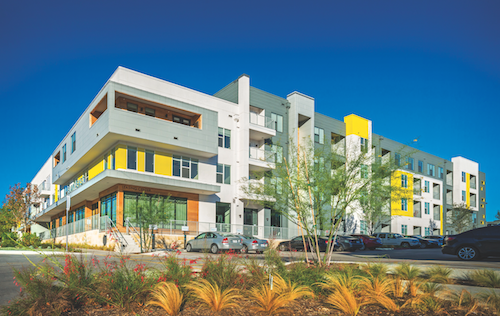 Elan East, a multifamily project in Austin, Texas, consists of 245 apartments and presents a backdrop of charcoal-gray colored siding, contrasted with white stucco boxes highlighted by yellow accents. The project was designed by the Michael Hsu Office of Architecture, Austin, in conjunction with Meeks + Partners, Houston, and developed by Greystar, of Charlotte, N.C. [Photo: Jud Haggard]
Elan East, a multifamily project in Austin, Texas, consists of 245 apartments and presents a backdrop of charcoal-gray colored siding, contrasted with white stucco boxes highlighted by yellow accents. The project was designed by the Michael Hsu Office of Architecture, Austin, in conjunction with Meeks + Partners, Houston, and developed by Greystar, of Charlotte, N.C. [Photo: Jud Haggard]
The International Style grew out of the work of architects such as Walter Gropius, Ludwig Mies van der Rohe, Le Corbusier, Richard Neutra, and Philip Johnson. Johnson’s Glass House in New Canaan, Conn., is a prime example. But while buyers may admire the stark modernism of such buildings, it’s not what they want in a new home.
“Most people [visualize] a mono-slope or shed roof, or some combination of those forms,” says Larry Moore, senior partner with BSB Design, in West Des Moines, Iowa. “We haven’t had any [builder clients] ask for, or let themselves be pushed toward, that harder-edged, cleaner, sleek contemporary look with flat roofs and massive expanses of glass.”
Steve James, founding principal of DTJ Design, in Boulder, Colo., says, “We’re using detailing to add texture and color that gives a bit more softness to what some might perceive as an austere modern box. But we’re also trying to acknowledge an aspect of romance in the buying process. Depending on the region, you can find different ways to do bracketing and material transitions that add warmth.”
BSB Design is doing a substantial amount of work in Denver, where communities such as Lowry and Stapleton are the exception to the “contemporary won’t sell” rule. Newer communities are adopting design guidelines that specifically include contemporary.
“The versions [that architects produce] need to blend in with those old styles and keep the neighborhood harmonious,” Moore says. “And typically that means a few pieces [of contemporary] thrown onto very conventional houses.”
Delicate Balance
TRI Pointe’s Grable comments, “Designers do a pretty good job of pushing builders to be more creative and in fashion with the look and feel of the day. But we still have to keep in mind who our buyer is, and be careful about going too far out on the design limb, so to speak.”
The good news, he says, is that “a lot of those urbane buyers are thought leaders, and over time their [housing preferences] will filter down to a greater marketplace. So, over time, we’ll start to see contemporary aspects introduced into the more suburbanized or outer edges of our markets.”
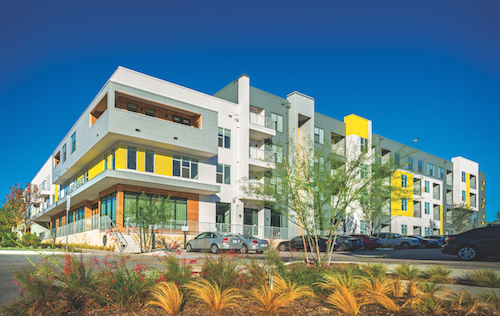
It's All About Context: Read more about ETCO Homes' take on contemporary and how the builder has found its sweet spot: luxury condominiums built on infill sites in Beverly Hills, Calif. PB
[Photo: Jud Haggard]
Advertisement
Related Stories
Design
2023 BALA Winners: The Best of the Best
You'll find plenty of inspiration in these four award-winning projects from the Best in American Living Awards
Design
What Gen-Z Buyers Really Want in a Home
The fervor of planning for Millennials in the home building industry has now pivoted to Gen Z. So, what does this new generation want?
Design
4 Luxury Production Home Designs to Inspire
Yes, these are designs for production homes, but you won't find any cookie-cutter repetitive elements in this high-end selection


